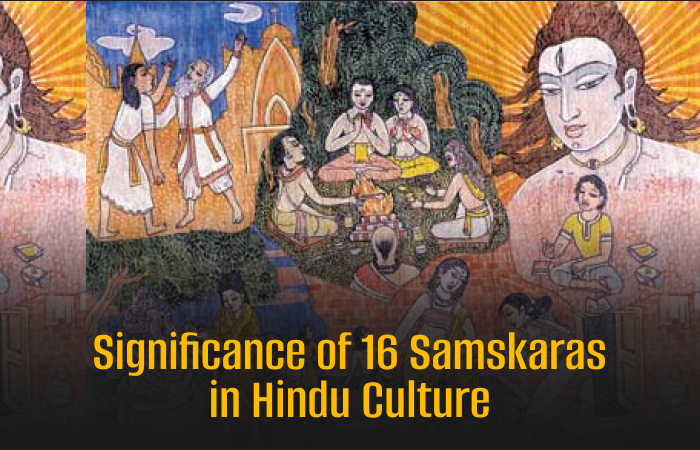Significance of 16 Samskaras in Hindu Culture!

In our Sanatan tradition, there are sixteen important rites called Sanskars that mark various stages in a person’s life. The term “Sanskars” refers to the process of purification through refinement and cleansing, involving spiritual, physical, and divine aspects. Our scriptures emphasise the belief in reincarnation, and Sanskars play a crucial role in purifying the soul across different lifetimes. Moksha, or liberation, is considered attainable through these rituals, helping the individual free themselves from the impurities accumulated through numerous births.
The Sanskars cover all aspects of human life, addressing Adhyatmik (spiritual), Aadhibhautik (physical), and Aadhideivik (divine) dimensions. By observing these rites at various stages of life, a person can cleanse themselves from the impurities carried over from previous births, totalling eighty-four lakh yonis or life forms. Now, let us know about them in detail.
What are the 16 Samskaras in Hindu Culture?
The 16 Samskaras cover the entire journey of a human life. There are 4 rituals before a newborn’s birth, 11 rituals throughout their life, and 1 ritual after the soul departs the body.
Love and happiness grow when shared. The importance of these rituals is to celebrate and share the important milestones of life with loved ones, receive their blessings, offer prayers together for positivity, and take a break from the daily chaos.
Here’s how you can apply the 16 Samskaras in modern life –
There are 03 Pre – Natal Samskaras – Garbhadhan, Pumsavana and Simantonnayana. They are as follows:
- Garbhadhan (Conception)
The first union of husband and wife to conceive is called “Garbhadhan,” where “Garbha” means womb and “Dan” means donation. It signifies a man placing his seed in a woman. The Taittiriya Upanishad emphasises continuing the lineage, urging not to terminate it. The Garbhadhan Sanskar purifies the body and mind of parents expecting a child. The ritual involves a prayer to the Goddess, seeking the power to bear a child, and invoking deities like Ashwinikumar, Mitra, Varuna, Guru Brihaspati, Indra, Agni, and Brahma to fill the woman’s womb. After nine months, a prayer to Lord Brahma seeks blessings for a healthy child, capable of a long and fulfilling life.
2. Pumsavana: Secure the birth of the child
Pumsavana and Simantonayana are exclusive to a woman’s first pregnancy. Pumsavana occurs when the first signs of conception appear, preferably during the moon’s presence in a male constellation like Tishya-nakshatra. This ritual aims to purify the child in the womb, fostering mental development. Essential for a healthy and bright child, it takes place during an auspicious time, aligning with Shubh Nakshatra and ensuring the overall well-being of both the child and parents.
3. Seemantonnayana/ Simantonnayana: Parting the hair
In the seventh month of pregnancy, a special Sanskar is performed to pray for the baby’s healthy physical and mental growth. This Sanskar also aims to provide a sense of peace for the expectant mother, especially during the last three challenging months of pregnancy. Through a puja, they purify the surroundings as an offering to God, seeking comfort for both the mother and child and hoping for a calm and holy delivery. This ritual is mostly social and celebratory, bringing joy and upliftment to the pregnant mother.
Childhood Samskaras: The Jatakarma, Namakarana, Nishkramana, Annaprasana, Chudakarana, and Karnavedha are Childhood Samskaras.
4. Jatakarma: Natal rites
The Jatakarma, a crucial samskara, is performed at a child’s birth, symbolising the separation from the mother’s womb. The father feeds the newborn a mixture of sugar, honey, and ghee with a golden stick while chanting Vedic mantras. The father blesses the child, cuts the navel string, and wishes for a long life. Sages assess the celestial alignment for auspiciousness, and if unfavourable, the Jatakarma eliminates negativity. The child is bathed in milk, sanctifying what was consumed in the womb. The sacred “OM” is inscribed on the baby’s tongue, fostering spiritual inclinations.
5. Namakarana: Ceremony for naming the child
The Vedic tradition of naming a child occurs around the eleventh or twelfth-day post-birth. During the Namakarana ceremony, parents formally announce the child’s name following traditional naming customs. This significant event takes place in the presence of family members and relatives, providing a distinctive identity to the newborn. The ceremony holds cultural and familial importance as it marks the official introduction of the child to the community with the chosen name.
6. Nishkramana: First outing for showing the sun
Nishkramana, meaning “going out, coming forth,” occurs in the fourth month after a baby’s birth. Parents take the baby to a nearby temple, introducing them formally to the world. This ritual initiates the child’s mental growth as impressions are formed based on what the baby sees and hears. It signifies the beginning of the baby’s interaction with the external environment, influencing their early cognitive development.
7. Annaprasana: First feeding with boiled rice in 6 months
Annaprasana, performed in the sixth month or upon the emergence of the baby’s first teeth, signifies the introduction of solid food, usually cooked rice. Before this, the baby relied solely on breast milk for nourishment. The ceremony aims to bestow good health, radiance, and physical strength upon the child. It marks a significant milestone as the baby transitions to consuming solid food for the first time, symbolising their growth and development.
8. Chudakarana: Arrangement of the hair tuft
It is also known as Mundan Sanskara. This ritual signifies the child’s first haircut and marks a new phase of life. During this ceremony, the baby’s hair is cut and the nails are trimmed, symbolising cleansing, renewal, and new growth. Scientifically, hair on the head protects from environmental elements while enhancing appearance. The purpose of this sanskara is to promote the growth of strong and clean new hair, contributing to the child’s well-being and aesthetics.
9. Karnavedha: Piercing the earlobes
Karnavedh, or ear-piercing, holds significance with a scientific explanation. The ear lobes contain a crucial acupressure point, and research by neurologists reveals a connection between the earlobes and the brain hemispheres. Piercing the ears is believed to aid in developing intelligence and boosting immunity against respiratory infections, along with protecting against diseases like hydrocoele and hernia. This sanskara is not only a cultural practice but also holds potential health benefits supported by scientific understanding.
Educational Samskaras: The Vidyarambha, Upanayana, Praishartha, Keshanta/ Ritusuddhi, and Samavartana are educational Samskaras.
10. Vidyarambha: Learning the Alphabets
Typically conducted around the age of five, Vidyarambha is a ritual celebrating a child’s formal initiation into learning. In the Vedic tradition, Saraswati, the goddess of knowledge, is worshipped during this ceremony to seek blessings for the child’s educational journey. Following the guru-shishya parampara, the student embarks on the learning path, residing with the guru as part of their family. The emphasis is on leading a disciplined life and focusing steadfastly on acquiring knowledge and gaining wisdom.
11. Upanayana: Holy thread ceremony
Considered the paramount sanskara, Upanayana signifies the crucial intellectual and mental development of a child. “Upa” means ‘close,’ and “Nayana” means ‘to bring,’ making Upanayana translate to bringing closer to the guru or Divine. Interestingly, this ceremony was once conducted for girls as well, but societal norms led to its discontinuation several centuries ago. The ritual remains a pivotal tradition in recognising the spiritual and educational growth of individuals.
12. Praishartha: First study of the Vedas
Vedārambha signifies the commencement of Vedic learning. While Upanayana marked the initiation of education, Vedarambha specifically denotes the start of Vedic study. In this sanskara, students, guided by their lineage, delve into the mastery of the Vedas. This ritual underscores the pivotal moment when each learner embarks on the profound journey of understanding and mastering sacred texts, emphasising the significance of Vedic education in cultural and spiritual traditions.
13. Keshanta/ Ritusuddhi: Cutting the hair
‘Kesh’ signifies hair, and ‘anta’ means end. The Keshanta sanskara involves a student’s inaugural beard shaving upon reaching maturity, typically with the initial growth of facial hair. Simultaneously, for girls, the Ritushuddi ceremony is observed at the onset of menstruation. Both ceremonies mark a crucial transition from childhood to adulthood, prompting the individual to acknowledge and comprehend the physical and psychological changes that accompany this significant juncture in life.
14. Samavartana: Graduation ceremony
Samavartana, translating to returning home from the house of the Acharya, represents the student’s departure from the guru’s abode upon completing studies within the Gurukul system. This sanskara, marking the conclusion of formal education, symbolises the student’s readiness to progress to the next stage of life. In the traditional Gurukul setup, it signifies the transition when the student is prepared to leave the mentor’s guidance and apply the acquired knowledge to navigate the journey ahead.
15. Vivaha: Marriage
The most important ceremony in Hinduism is the wedding, known as Vivaha. It starts with the engagement and ends with the Praavisya Homam or Nishekam ceremony. The whole process lasts for several lively days of celebration. This special union represents the end of many rituals, showing the commitment between a couple. The wedding ceremonies include diverse cultural traditions, creating a strong bond between the husband and wife as per Hindu customs.
16. Antyeshti: Funeral
Antyeshti, the last sanskara in a Hindu’s life, is conducted by relatives after a person’s demise. Aligned with Hindu scriptures and the Bhagavad Gita, which suggests the soul undergoes rebirth after leaving the old body, the final rituals are meticulously performed with the assistance of Brahmin priests. Following ten days of mourning, a purification ceremony occurs on the eleventh day. On the thirteenth day, a feast symbolises the soul’s successful transition to its ultimate resting place.
Sanskars are regarded as an essential rule in our ancient Sanatan Hindu tradition, and not following them is seen as rendering one’s life incomplete. Even omitting a single Sanskar can be considered a defect in one’s life.
Without undergoing Sanskars, various flaws, such as inherent nature defects, speech-related issues, behavioural problems, distorted perspectives, physical and mental deformities, and a lack of noble qualities like righteousness, knowledge, and detachment, may be observed in human life. Embracing Sanskars is a tradition and a pathway to leading a complete and enriched life.









